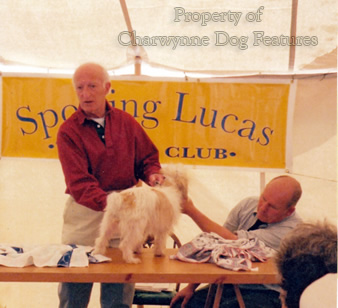928 ASSESSING THE WORKING TERRIER
ASSESSING THE WORKING TERRIER
by David Hancock
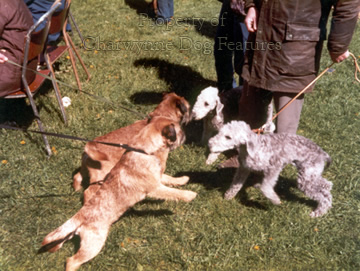

Of all the sporting breeds, I find that terriers are the hardest to judge. They are often feisty, wriggly, more interested in the adjacent dog than the judge, elusive and evasive. Their movement is usually keenly towards the nearest fellow exhibit and their lead-training often deficient. As a direct result, I find that unwise decisions are often made by judges who are simply unable to study movement or spend enough time going over the exhibits in a relaxed hands-on examination. I could never judge construction without having the exhibit up on a table, giving easier control for a thorough hands-on conformation check. On the ground, small legs moving erratically in a blur of straining limbs are rarely capable of showing off their true normal gait. If their handler can't show off their movement then how can any judge form an opinion? At Kennel Club terrier shows, the entry is so much more relaxed, better lead-trained and, frankly, more comatose! Most of the exhibits lack working instincts and are therefore less frenetic and easier to 'go-over'.
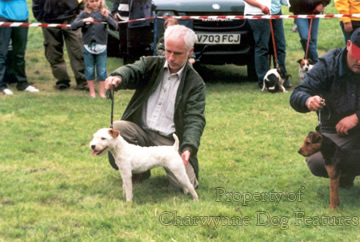

But even beauty shows for a sporting breed should end up rewarding a working physique rather than one just cosmetically appealing. But what should 'working appeal' be based on? The original working Fox Terriers were barrel-chested and featured a fairly straight stifle and hock; the longer tibia and well-bent hock of the show ring terrier of today is not much use underground. But an even bigger difference lies in the shoulder angulation and depth of chest. Show terriers feature, almost without exception, upright shoulders and slab-sided but deep chests; neither of these physical attributes help an earth-dog. Nor does the short back of the taller pedigree terriers, which reduces flexibility and overall suppleness. It does however produce a more compact-looking, showy type of dog.

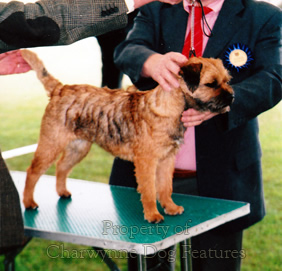
The craze for long heads in show terriers, exemplified most clearly in the smooth Fox Terrier, is rooted in the misguided belief that length gives power. You also hear the expression: "plenty of heart room", which is strange when the heart doesn't actually change size when the dog is exerting itself. Plenty of lung room is desirable, especially in terriers that run with the hounds. But it is rib-space which gives a dog lung room, not depth of chest. I have heard terrier show judges fault a very muscular terrier, used to hard exercise, for being 'loaded at the shoulders' when the fortunate dog had developed muscle which projected on the outside of its shoulders. Any individual accepting a judging appointment should question their own capability and 'eye for a dog' before proceeding.
Symmetry is important in most working animals; in a Fox Terrier measuring two feet from the top of its head to the ground, its front should cover not more than eight inches in width, a proportion of at least 1 in 3. The long muzzle, short back and upright shoulders are easily spotted and sadly are now the norm, held as the perfect earth-dog blueprint, the ideal anatomy for a sporting terrier! Working terrier enthusiasts will never show great interest in precise measurements, exact proportions or wordy descriptions of anatomical features. But balance, symmetry, correct proportions and physical soundness really do affect function and therefore performance in a hunting animal. Working Terrier show judges may prefer to judge entirely by eye and experience, but is this enough? A seminar of working terrier judges to bring on the younger judges would surely be of value. It would be interesting to hear, should that happen, what working terrier show judges' decisions are being based on. 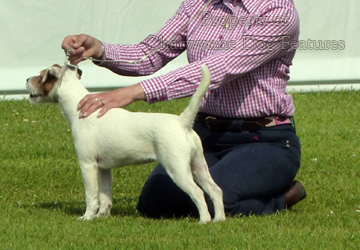
Whenever I judge, I just have to proceed to a set format, a regular sequence and a comprehensive plan - or I'm sure I'd miss a feature that counts. This routine matters most when each exhibit is on the table before me. I always start at the forehand, examining the head, the jaw especially, the neck and then, with both hands-on, the set of the shoulders. The bone and muscle of the fore-legs, the soundness of the feet and the position of the elbows come next. Moving on to the torso, I look for good length in the rib-cage, not too wide a 'spread', a level top-line, strength of loin and a strong root to the tail. I am looking for strongly-muscled hindlimbs but not over-angulated hindlegs, and a well-set tail. When judging movement, I aim to penalise any exhibit 'carrying a leg' - a sign of a loose kneecap, but look out for 'stride' - far too many terriers move like millipedes with fast-moving tiny strides, so often created by upright shoulders. Extension, fore and aft, really does matter. A working terrier lacking a weatherproof coat should never win in the ring - leave that to the KC beauty shows!


Pedigree livestock are still judged to a scale of points; pedigree dogs no longer are. Subjective judgements can bring fine differences of opinion to the fore. But for a working terrier to win a prize with upright shoulders, splay feet, a wry mouth and no lung room, as I once witnessed, is more than depressing. If countrymen can't judge a dog these days, what hope for terrier judges at Kennel Club shows?
